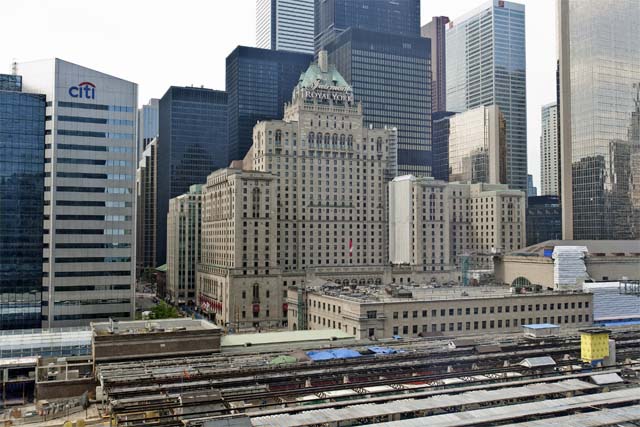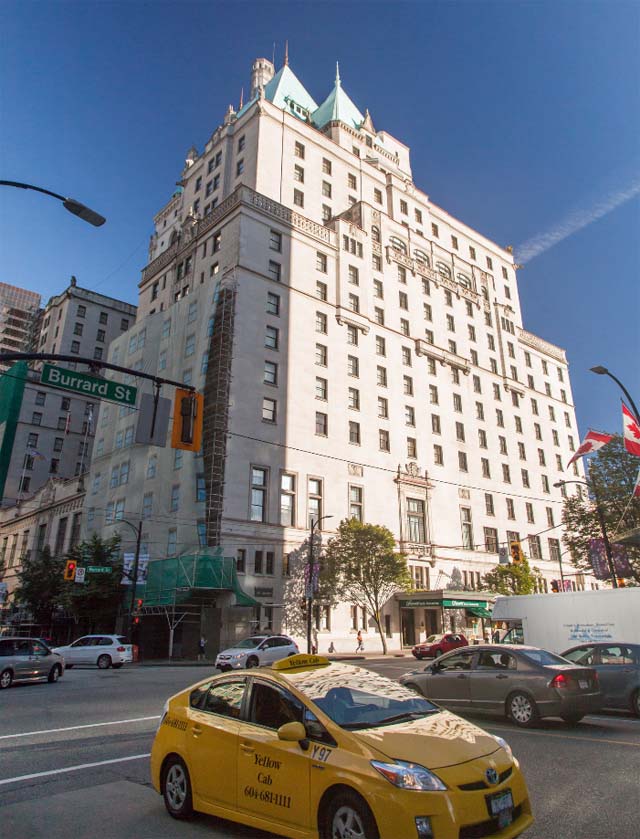|
The Fairmont Hotel Vancouver - Date unknown Remy Scalza.
1 July 2014
New Owners for Some of Canada's Landmark Railway Hotels
Canada - The age when rail travel dominated in Canada has long passed.
But the railway-built hotels that era left behind have retained much of the glory and glamour of that period.
Now a decision by Ivanhoe Cambridge, which is owned by Quebec's largest investment fund, to largely eliminate hotels from its holdings has put a handful of
Canada's most famous landmarks on the market.
First to go last year was the Fairmont Chateau Laurier in Ottawa, a turreted, stone-clad castle, that was home to some prime ministers and which is often
assumed by some tourists to be part of the neighboring Parliament buildings.
The ivy-clad Fairmont Empress in Victoria, British Columbia, was sold last week to a real estate developer, Nat Bosa, and his wife, Flora.
That leaves two hotels on the market: the Fairmont Royal York, once the largest hotel in the British Empire, which still commands part of Toronto's
skyline, and the Fairmont Hotel Vancouver in British Columbia's largest city.
"A lot of buyers see this as an opportunity to have a hotel that tells a story beyond its returns," said Sebastien Theberge, a spokesman for Ivanhoe
Cambridge.
"There's a lot of pride in these properties."
The hotels are such integral parts of their cities, Mr. Theberge said, that his company broke with its usual practice of not announcing sales until they closed
to avoid igniting panicked rumors about their fates.
 The Fairmont Royal York in Toronto - Date unknown Steve Payne.
Like the Chateau Laurier, many of Canada's railway hotels were designed, to varying degrees, to resemble castles.
Harold Kalman, an architectural historian based in Vancouver, said that stemmed largely from a decision by William Van Horne, the general manager and later
president of the Canadian Pacific Railway, who was also an amateur architect.
The hotels owned by the rival Canadian National railroad further raised their profiles by hosting Canada's first public radio stations.
The Canadian Broadcasting Corporation moved its Ottawa radio studios out of the two top floors of the Chateau Laurier only 10 years ago.
Yousuf Karsh, an early photographer of the wealthy and famous, lived and kept a studio in the hotel.
Combined with their central locations, Mr. Kalman said, "there are probably dozens of connections where the community can actually be linked to the
hotel."
He noted that when he married for a second time in Ottawa, the reception was held at the Chateau Laurier.
"We really didn't think of any other place," he said.
Fairmont Hotels and Resorts, which still manages most of the Canadian railway hotels, is directly descended from the hotel operation Van Horne established at
Canadian Pacific.
It was spun off by the railway in 2001, and six years later it sold most of its Canadian properties, including the batch that went to Ivanhoe
Cambridge.
Mr. Theberge said that a strategic review after a change in senior management led Ivanhoe Cambridge to get out of the hotel business in the belief that better
returns could be found in other real estate sectors.
At the peak in 2009, Ivanhoe Cambridge owned more than 70 hotel properties worldwide.
Now it is down to nine.
The real estate company, which is owned by Caisse de Depot et Placement du Quebec, will keep three of those properties: Fairmont Le Chateau Frontenac,
which looms over Quebec City and hosted meetings between Franklin Roosevelt and Winston Churchill during World War II, Fairmont the Queen Elizabeth, which sits
across from a major office complex that Ivanhoe Cambridge owns in Montreal, which is adjacent to the real estate company's headquarters and in which it has a
51 percent interest.
Because of their status, Mr. Theberge said that the railway hotels were being sold through a special process.
Fairmont retains a final say in any sale and buyers must show that they have the means and commitment to invest in the properties, which, as is the case with
the Empress, can be over a century old.
"These properties require constant love," he said.
Ivanhoe Cambridge just spent 75 million dollars on repairs and renovations to the Chateau Frontenac.
Mr. Bosa, the president of Bosa Development, which is based in the Vancouver suburb Burnaby, said that he first looked at the Empress with an eye toward
putting condominiums along part of Victoria's scenic waterfront.
But when he walked through the hotel's doors for the first time, Mr. Bosa said that "I fell in love with an old mistress. It was not my traditional real
estate deal. This is a true love attraction and we're going to do the right thing."
Not only is Mr. Bosa now firmly opposed to using the land surrounding the Empress for development, something that would have provoked an outcry in the city, he
said he planned to invest about 40 million Canadian dollars over the next four years in renovating the building, which has 477 rooms.
"We don't want to put more lipstick on it," he said.
The final return on that investment, he acknowledged, may ultimately be less than ideal.
"It really borders between philanthropy and business," he said, adding that Fairmont would continue as the hotel's manager.
Many of the other railway hotels once owned by Fairmont went to the Ontario Municipal Employees Retirement System through its subsidiary, the Oxford Properties
Group, in 2007.
While it has no plans to get out of hotels, in May it did sell 65,000 largely undeveloped acres in Quebec that came with Fairmont Le Chateau Montebello, a
massive log structure on the Ottawa River, for about 50 million dollars.
Mr. Bosa did not rule out looking at the Hotel Vancouver.
But he vowed that if he did go that route, he wouldn't again be blinded by love.
"That one would be different," he said.
"That one's business."
Ian Austen.
|


